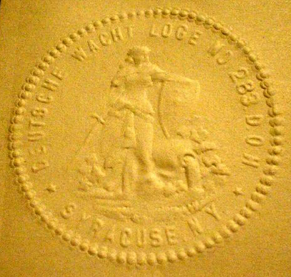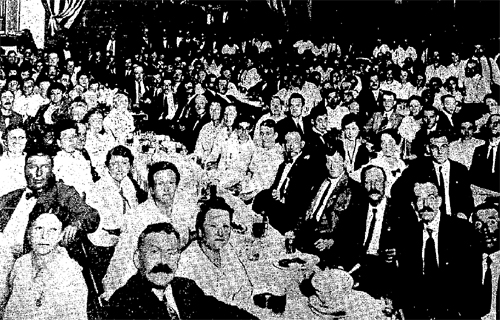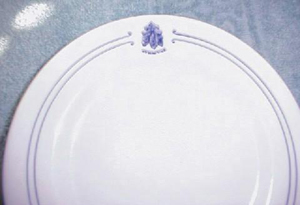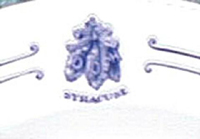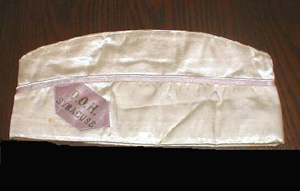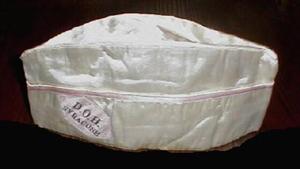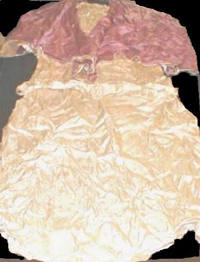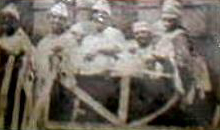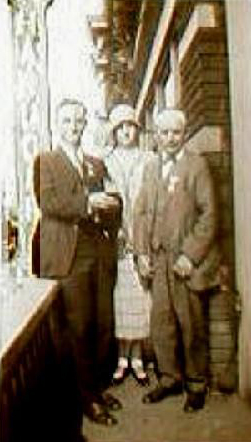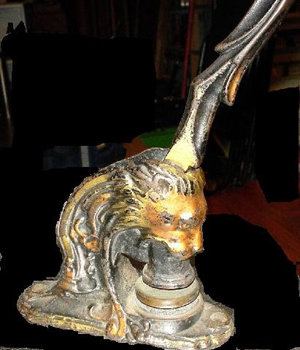German Immigrant Ancestors
in Syracuse and Onondaga County, New York
|
Harugari
German Order of the Harugari
Deutschen Ordens der Harugari
D.O.H.
|
Start researching the lives of your German ancestors in the Syracuse area, and you may find that they were members of something called the D.O.H., the “Freie Brüder Loge,” or the “Elizabeth Lodge.” These clues mean that your past family members were at one time affiliated with the Deutschen Ordens der Harugari (D.O.H., or Harugari, for short). This fraternal organization for German families in America was founded in New York City on 8 March 1847,* and rapidly spread across the country wherever Germans had settled. For over 100 years the Harugari helped to keep German culture alive in America by promoting German song, dance, good food, and friendship. The varied events at the meeting places across the country featured German orchestras, singing groups, and dance groups, showcasing a wide variety of German music and traditional dance. “Home-cooked meals” of Schnitsel, Roladen, Sauerbraten, and Wurst, with traditional noodles, salads, and desserts would be served with good German wine and beer. The Harugari also sponsored festivals and events such as Bierfest, Schlachtfest, Schillerfest, Seemannsabend, Oktoberfest, and other holiday celebrations to honor the culture of their ancestors. The Harugari dedicated itself in particular to the preservation and support of the German language. One of its other important original purposes was to provide a way for German immigrants to band together and find strength in numbers. Their local lodges were intended to provide mutual support, services, and encouragement to members in need, including disbursing payments to sick members who couldn’t work, or death benefits to the widows and orphans of deceased members. In this way, the lodges acted as early insurance societies within the immigrant communities. An equally important purpose of the Harugari was to provide ethnic solidarity among the members, and a regular meeting place where they and their families could gather to practice, preserve, honor, and enjoy among themselves and with their neighbors their native language, literature, food, music, traditions, and customs. They sought to keep the best parts of their German heritage a cherished part of their new adopted homeland. Their motto was, “Friendship, Love, and Humanity.” Although the Harugari, like so many other formerly robust fraternal organizations of the late 1800’s and early 1900’s, has long since withered away from national prominence, the Harugari German-American Club of West Haven, Connecticut, remains active today and offers some historical information on its website: The name Harugari comes from the old Germanic word “Haruc.” It may be roughly translated to mean “The Teutonic spirit (or priest) of the oak tree.” Thus, it is a meeting place symbolized by the majestic oak trees, reminding us of the spirit of our founders. 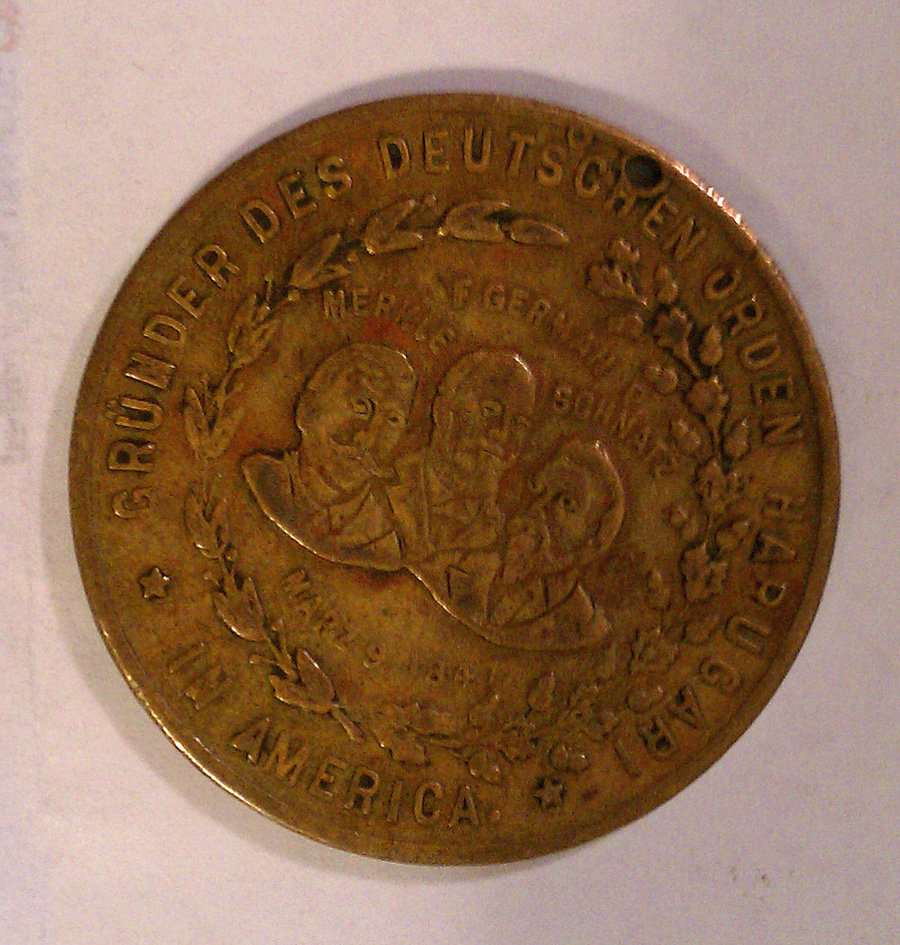 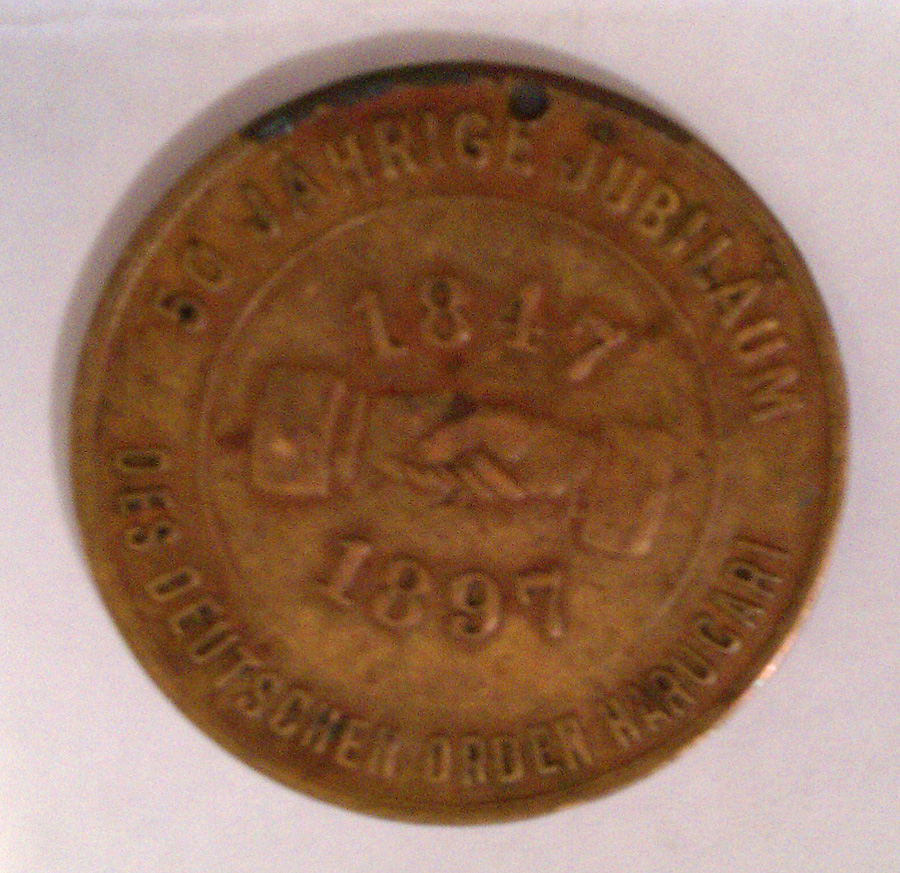 Jubilee year Harugari medallion photos courtesy of Kim Kornfeld.
The Golden Age of the Harugari as a fraternal organization in America seemed to begin in 1871 when Prussia emerged as the victor in the Franco-Prussian War and united numerous formerly separate kingdoms and territories of German people into a single German Empire (inspiring a new nationalistic pride in German emigrants everywhere). And clearly the Golden Age of German pride ended with World War I, when in the U.S. the rapid spread of suspicion and dislike of anything German, including the German language, eroded the neighborly goodwill formerly enjoyed by ethnic Germans and their groups such as the Harugari. World War II dealt the final blow, and by the 1960’s and 1970’s, one finds very few mentions of the Harugari anywhere other than in the newspaper obituary columns. See the New York Times article from 25 August 1895, “The Order of Harugari” for more historical background.
The Harugari in Syracuse—Beginnings According to the book, Geschichte der Deutschen in Syracuse und Onondaga County, the first lodge of the German Order of the Harugari established in Syracuse was the “Syracuse Loge No. 30” in 1850:* “This local lodge held its meetings on Monday evenings in the Ackermann Building and lasted until 1857 when most of its members joined the Odd Fellows and the Lafayette Lodge No. 489 was established.” The next Harugari lodge in Syracuse was born on Christmas Day, 1867, when an official of the Auburn, New York lodge installed the Central City Lodge No. 161 of the “Altdeutschen Orden der Harugari” in Syracuse. This lodge would later (by 1897) become known as the Central City Lodge No. 154 of the Harugari. The lodge destined to be one of the largest and longest-lasting was the Deutsche Wacht (“German Watch”) Lodge No. 283. According to a speech given in Syracuse by Alexander von Landsberg in 1906, this lodge was organized in Syracuse by him and others on 9 June 1869. Van Landsberg had been owner-editor of the German-language newspaper, The Syracuse Union, from 1870 to 1895. He had also been a Syracuse school commissioner and tax collector, and was at one time elected Gross-Barde (head official) of the Harugari of the United States. But contrary to his claim, according to another source, the Deutsche Wacht Lodge of Syracuse was started as a branch of the Deutschen Ordens der Harugari in 1872. On 1 May 1871, 154 men and uncounted women and children of the Harugari marched and rode in the 4th Division of the Syracuse Peace Parade (Friedensfeste) organized by the Germans of Syracuse to celebrate the victorious end of the Franco-Prussian War: “The Harugari Lodge had in their conveyance an oak tree representing the ‘German Oak,’ on whose branches were mounted over 100 German and American flags, around which a group of girls sat, dressed in white.” In the 1880’s, as more German immigrants than ever before began flooding into the United States, the Harugari in Syracuse grew rapidly. On 19 February 1882 the “Freie Brüder Loge No. 458” was founded with 29 members and $87 in the treasury. This lodge met in Ackerman’s Hall, and was reportedly very successful right from its beginning, in paying out support for the sick, death benefits to the bereaved, and other charitable contributions. On 24 October 1886 the Humboldt Lodge No. 573 was founded in Syracuse, and on 15 March 1891 the “Elisabeth Loge No. 22” was founded by the ladies, with 130 female members. In 1897 the book Geschichte der Deutschen in Syracuse und Onondaga County totalled up seven Harugari lodges in Syracuse:
On 8 March 1897 all of the local Syracuse lodges celebrated the Harugari’s Golden Jubilee (50th anniversary) “in the good old German way” with a street parade in the afternoon and a gala evening concert and dancing at the Syracuse Turn Hall.
The 1900’s Foreign-born Germans, the largest ethnic minority in Syracuse, were numerous and growing ever more publicly prominent in Onondaga County by the early 1900’s. Twenty-five thousand people in Syracuse spoke German in 1897, when their affinity for civic and community service and public display and their growing affluence and influence were undeniable. The first mayor of Syracuse of German heritage had been George P. Hier, elected in 1875 (his father, Ernst Höcher, had arrived in Syracuse in 1833). More recently, the son of a German immigrant, Jacob Amos, Jr., was elected mayor of Syracuse for two terms (1892-1896). The The Philip Eckel monument was erected on the German North Side in 1900, while 1905 marked the year the Sniper monument was installed in Schlosser Park. Around the turn of the century all fraternal organizations were booming, and the Germans were no exception. Onondaga County members of the Harugari regularly hosted the New York State Convention in Syracuse, and they celebrated the 58th anniversary of their organization in Gilcher’s Hall on 10 April 1905. The 1905 celebration of the 100th anniversary of Schiller’s death was celebrated by all of the many German organizations in Syracuse, the Harugari included. When “Deutsche Tag” (“German Day”) was instituted in Syracuse in 1908 to raise funds for a monument to Schiller and Goethe, the Harugari members threw themselves into its support along with over 70 other participating German groups organized together as the Deutscherbund. That first parade, on 3 August 1908, included over 2,000 people. The German Pioneer Society members rode in 25 carriages. Members of all the Harugari lodges marched, along with the military unit known as the “Walhalla Commandery of the D.O.H.” Humboldt Lodge had a float showing a German field hospital, and Augusta Lodge also had a “pretty” float in the parade. The following year “German Day” coincided with the annual Harugari State convention being held in the city. Crowds at these parades and evening festivities were enormous. Later when the monument to Schiller and Goethe was erected in Syracuse’s Schiller Park in 1911, it was said that the Harugari had contributed the largest amount of money to the cause.
In 1912 there were about 3,000 members of the D.O.H. in the Syracuse area. The D.O.H. was said to be made up mostly of first-generation Germans and had become one of the largest fraternal bodies in the United States, having paid out $1 million in sick and death benefits the previous year. The D.O.H. claimed approximately 50,000 members in New York State alone. There was talk that year of the Order of the Harugari building a home for elderly Germans, and talk that it might well be located and built in Syracuse. But just a handful of years later, the tenor of the times was inexorably changing. In August, 1916 the Harugari’s three-day annual state convention held in Syracuse was well attended, and closed triumphantly with a picnic at Onondaga Lake and an evening banquet at Armbruster’s Hall. Newspaper coverage revealed that $12,000 had been raised by the D.O.H. lodges of the State of New York for the German war relief fund. But once the United States abandoned its neutrality and entered the war to fight as an ally of France and England against Germany, it would be deemed anti-American and even traitorous to be sending any aid to Germany at all. On 3 February 1917 a German submarine sank the American ocean liner Housatonic off the coast of Sicily and the U.S. broke off diplomatic ties with Germany. (The English ship Lusitania had already been similarly torpedoed by a German submarine on 7 May 1915). Germany’s declaration of unrestricted submarine warfare on all shipping, including that of neutral countries, was among the factors that ultimately led to the United States declaring war against Germany on 6 April 1917. Suddenly the image of what a German was changed drastically all over the U.S.—and across Onondaga County. Headlines began appearing along the likes of these: “Canadian Troops Crucified and French Girls Burned, Says William Allen White; Describes Systematic German Methods of Frightfulness; All of It is a Part of Official Germany’s War Theory” and “German Slavery is Death; Worst Barbarism in History” [Syracuse Herald, December 2, 1917, page 4]. Another headline on page 3 read: “Everyone Is Patriotic Citizen or Traitor, according to J.W. Gerard.” Mr. Gerard, the former U.S. ambassador to Berlin, was quoted in the Syracuse newspaper at length: “We have in this country a few American citizens of German descent who are in sympathy with Germany and doing all they can to aid the Kaiser. Do you think they will be better off with the Germans ruling this country? Was Benedict Arnold better off after he became a traitor? By the time the war was over and Germany was defeated, that old song, “Die Wacht am Rehin,” performed so stirringly and applauded so enthusiastically in earlier years by the Syracuse German singing groups, had been turned on its head, and as one Syracuse newspaper editorial quoted, there was now literally an “Anglo-French-American Wacht am Rhein!” and American soldiers were singing the song mockingly as they strolled the streets of Berlin. For many reasons those of German heritage in the United States during and immediately after World War I found little to sing about. The former support for and friendly attitude toward their German heritage in the general populace had long since been drained away, as suspicion, fear, and anger about anything German—especially Germans meeting in groups, speaking in their own foreign tongue—spread during and because of the war. In those years there were still many “Fraternal Orders” with their activities being regularly listed in the Syracuse newspapers, including many new and military-oriented societies serving veterans, aiding soldiers, and celebrating American virtues. But it is not surprising that the Harugari was no longer listed among them. |
|
|
In the 1930’s there were five Harugari lodges still active in Syracuse, and a Harugari Hall, or Temple, at 615 Butternut Street on the North Side, where the lodges met. The lodges during this period were:
By 1937 the various German groups in the area had joined together as the Syracuse-Onondaga United German Societies and on 14 February they put on a benefit performance of 300 musicians, dancers, and gymnasts at Lincoln Auditorium to raise money for the Red Cross disaster relief fund, in the wake of devastating flooding in the Ohio River Valley. The “Harugari drill team” participated. Once again, those of German heritage had found support, acceptance, and strength in numbers. But sadly, 1937 also brought the rise of Adolf Hitler and the Nazis on the international scene, and thus brought more suspicion of anything German in the U.S. being potentially subversive or traitorous. An article in the Syracuse Herald on 12 September told of a Nazi plot revealed by the Chicago Times, wherein the Americandeutscher Volksbund (an American pro-Nazi group trying to pass itself off as a German cultural organization) was working to seize future control of the U.S. by secretly forging links among the Nazis, Fascists (“Italian blackshirts”), and Communists (“Ukrainian brownshirts”) around the U.S. Onondaga County’s citizens who had lived through World War I must have felt a distinct sense of déjà vu in following world affairs, and once again those of German heritage must have felt a similar despair at seeing such stories reflecting on them. In 1938, a delegate from the Humboldt Lodge of the Syracuse Harugari presented the application of the Americandeutscher Volksbund to join the Syracuse-Onondaga United German Societies. The application was turned down by 14 out of 15 delegates’ votes, and the Grand-Bard of the New York State Order of Harugari, Albert Glanert, who also happened to be a member of Humboldt Lodge, issued this statement, which was published in the Syracuse Herald on 17 August 1938: “The Order (Harugari) accepts into membership only men and women of good character, sound body and good health, regardless of their religious belief or political affiliations. It strictly bars religious and political discussions and activities at its meetings and social festivities. Above all, it does not discriminate against other races. Jews as well as Christians of all faiths are eligible to membership. The Syracuse Harugari hosted the annual three-day New York State convention 25-27 August 1938, and celebrated the 93rd anniverary of the founding of the Harugari on 27 April 1940; both events were held at the Liederkranz Hall on Butternut Street and were publicized with brief notices in the Syracuse press. After the wars During and after World War II nothing was ever the same, not for anyone. The Order of the Harugari continued on, but many of its original purposes and practices no longer applied to a post-war American society. Without large numbers of new German immigrants settling in Syracuse, there was little need to assimilate and comfort homesick Germans in their native tongue. Germans were no longer the majority of immigrants moving into Syracuse. Immigrants of all backgrounds were more interested in assimilating to American practices as quickly as possible. Insurance companies now filled the need of support for the sick and the bereaved. Many second- and third-generation descendants of German immigrants would find more personally fulfilling social outlets among the non-German fraternal organizations in town; others just stayed home and watched that new-fangled time-waster, the television. But for some Syracusans and their families, the Harugari would always remain a tradition, an important and beloved part of their lives. Its glory days were gone; no more would the Germans of the city sponsor and march in massive parades or stage huge concerts, banquets, rallies, or balls. But some of those of German heritage still treasured the friendships they gained and the lessons they learned from the Harugari, welcoming the admonition to never forget the homeland, and continuing to support and preserve the Harugari’s ideals of friendship, love, and humanity. The membership was aging and dwindling. On 10 May 1951 Albert C. Shumacher was presented with a 50-year certificate at the 104th anniversary dinner of the Harugari’s Syracuse chapter, held at the Corner House. The following year the group held their annual anniversary dinner and dance at Antoine’s Zebra Room on Warren Street. On 17 May 1953, the Sisters of Augusta Lodge No. 135 celebrated the 50th anniverary of their lodge’s founding, along with the 106th anniversary of the Harugari. Mrs. Augusta Gessler was awarded a 50-year certificate at a dinner dance held at the Kirk Hotel. The 108th anniversary of the Onondaga district Harugari was celebrated 24 May 1955 with a banquet at Arion Hall. I cannot tell exactly how the Syracuse-Onondaga area Harugari met its official end. In searching through the Syracuse newspaper archives, I can only see that mentions of its activities gradually faded. Like the Turn Verein, the Arion Singing Society, the Liederkranz, and the Saengerbund, the Harugari withered as the cause of keeping the German cultural heritage and language alive in America grew less vital to those of the younger generations. Yet there are still those who remember the Harugari with affection for the good times they enjoyed and the values they were taught. They try to keep their promises to “Never Forget the Homeland” that was so dear to their ancestors. |
|
|
*A Syracuse newspaper item from 1904 claimed that the “Uniformed Rank of the Deutsche Order of Harugari” “was formed in Buffalo in 1836, the first lodge being Walpot Comturel No. 1. The Walhalla Comturel of this city [Syracuse] was the fourth to be installed. It was organized by Ernst Chitel, then of this city but now Elmira. He retired as Hoch Meister of the national organization this year.” I have not yet found any other sources confirming this earlier date of the Harugari's founding. All of the Haurgari anniversaries celebrated in Syracuse commemorated a founding year of 1847. See this collection of old newspaper articles on the Harugari.My sincere appreciation and thanks go to Dolores for her contributions to this webpage, including the photos of her impressive collection of Harugari artifacts. Without her generosity, this webpage would not exist. Her grandfather, August Schreiner, was treasurer of the Deutsche Wacht Lodge in 1935 and a longtime member; her grandmother was an officer and longtime member of the Augusta Lodge. Both lodges at that time met at Harugari Hall on Butternut Street in Syracuse. Additional contributions of information, memories, or photos of the Harugari would be most welcome. Please contact me. |
| Home |
